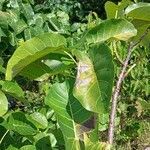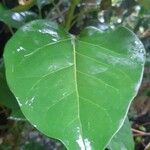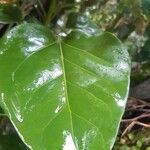Tree up to 30 (or more?) m tall. Branchlets 3-8(-16) mm thick, glabrous or sparsely, minutely puberulous. Stipules 1-2.5 cm long, glabrous or minutely puberulous, caducous; petiole 5-12(-20) cm long, glabrous or minutely puberulous with appressed brown hairs; blade coriaceous, ovate to elliptic, sometimes suborbicular or narrowly elliptic, 9-25(-32) x 7.5-17.5(-24) cm, apex rounded, obtuse, subacute or shortly acuminate, base cordate, sometimes to rounded, margin entire, glabrous above, glabrous or minutely puberulous with appressed brown hairs beneath; secondary veins 8-13 pairs. Figs in pairs in the leaf axils, (sub)globose, 1-2.5 cm in diam., minutely puberulous, at maturity greenish, sessile or occasionally up to 0.4 cm long pedunculate; basal bracts 2, 5-8 mm long; ostiole 4-8 mm in diam., more or less prominent.




